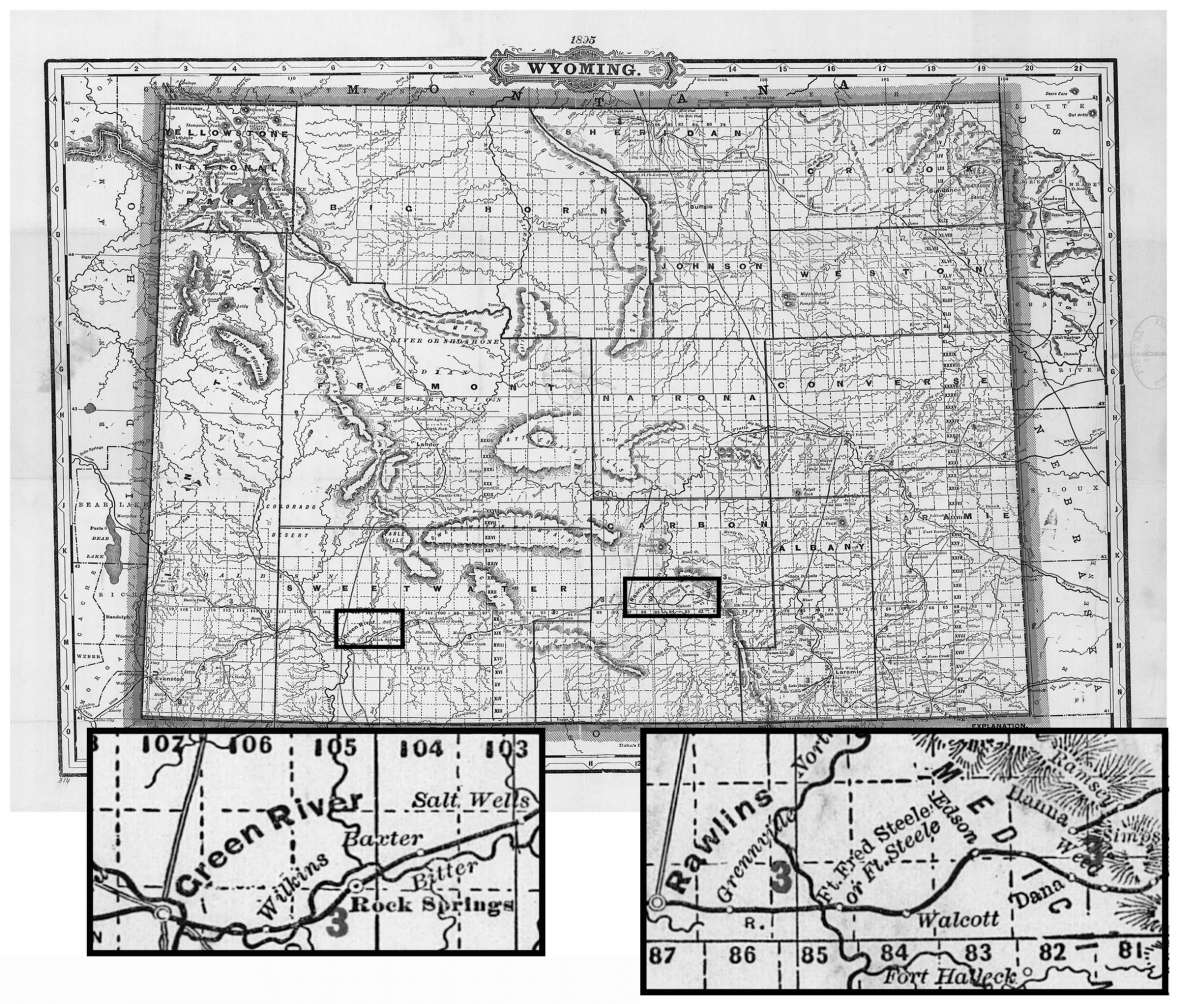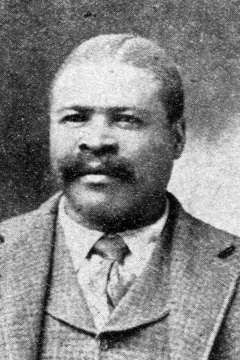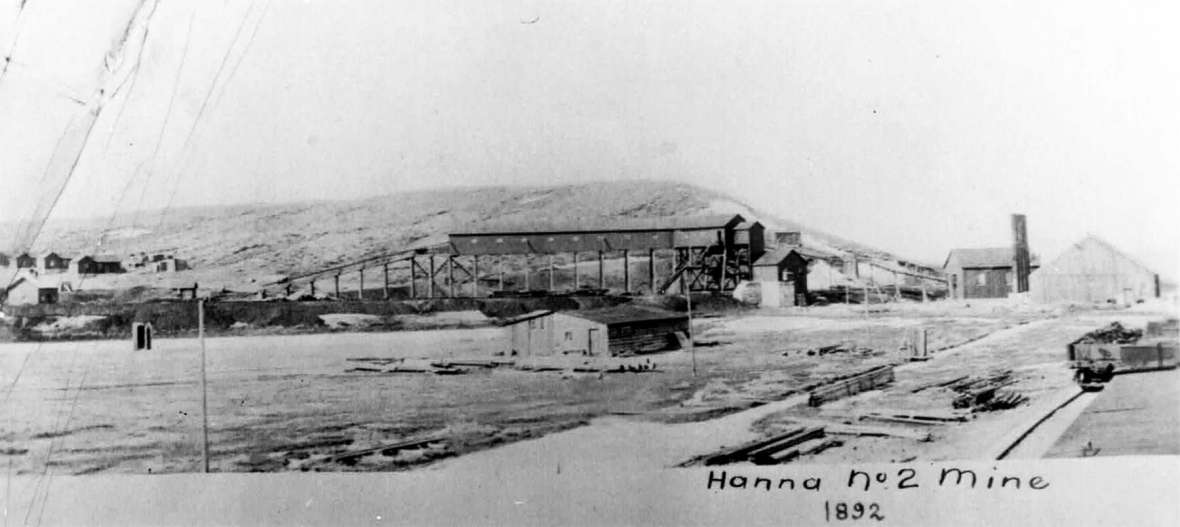- Home
- Encyclopedia
- The Forgotten Town of Dana, Wyo.: A Story of Bl...
The Forgotten Town of Dana, Wyo.: A Story of Black Legacy and Miners' Rights
The town of Dana, Wyo., has largely been forgotten in the history of the West, gone from living memory and barely mentioned in accounts of Wyoming’s boom-and-bust coal mining towns. Still, Dana is highly significant, especially to the history of Black Wyomingites. In the few short years the Dana mine was active, its Black miners inadvertently played a major role in bringing widespread attention to the issue of fair labor practices through their demand for equity and honesty in their work and pay. This important chapter in Wyoming’s history has only recently been brought to light.
The Union Pacific Railway section called Dana, which started out as a stage stop along the Overland route, spent most of its existence as quick water or rest stop along the transcontinental railroad—the Union Pacific Railway—a few miles south of Hanna and 150 miles west of Cheyenne. Dana’s story, however, peaks with a burst of activity between 1888 and 1891, when it became a Union Pacific Coal Company mining town. It represents the first documented occurrence of that coal company expressly recruiting a group of Black men to work in the Wyoming coal mines. It was, furthermore, the first and only Wyoming coal town where Blacks ever made up the ethnic majority.
Dana started as just one of several short-lived coal camps in southern Wyoming. Workers from nearby Carbon, Wyoming Territory, were sent to build the mine entrance and the processing equipment for the new Dana mine in winter 1888. Despite glowing public predictions about the output of the Dana mine, the UP Coal Company was aware of the poor quality and relative lack of merchantable coal at Dana.
The Panic of 1884 had caused a slump in the coal market, which gave birth to the first true labor union in the western mines, the Knights of Labor, and the first major miners’ strikes. As the economy was recovering in the late 1880s, the coal company compensated for those short-term losses by mining every seam that appeared even nominally viable. Dana was one of those questionable mines, but the company was determined to get as much coal out of the ground as fast as possible. The Carbon men quickly proved too few and the agents of UP Coal set to work recruiting more miners.

Miner recruitment and unrest
Recruiting diverse laborers for the coal mines was nothing new for the coal company. In 1868, the company opened the first mines in southwest and central Wyoming Territory at Carbon, Hallville, Black Buttes and Rock Springs. Most proved incredibly productive, especially in places like Rock Springs, where up to 10 mines were operating at once for several decades. As production grew, coal company officials, like typical 19th century industrialists, focused on profits. The best way to accomplish this, the industrialists thought, was to recruit laborers from impoverished areas in primarily Europe and Asia—people they could entice with the promise of riches and, for some, the ethos of manifest destiny in the great American West. The UP Coal Company started out with this same recruitment model in Dana.
These recruitment practices created some of the most highly complex social structures in the most ethnically diverse communities in the region. In the early days, the company owned and assigned all the housing, and routinely integrated neighborhoods. The thinking went that if they didn’t allow members of any specific nationality group to live near one another, they were less likely to form unions.
But there were exceptions and contradictions. Asian ethnic groups, which the dominant culture saw as too different to integrate, were mostly segregated well into the early 20th century. Rock Springs’s Chinatown is just one example of this practice. Black people often walked a fine line between integration and segregation since they were culturally part of mainstream America but still seen as “other” by White bosses. There were some plans to segregate Black miners in the coal mining town of Superior, Wyo., northeast of Rock Springs, in the early 1900s. Though that never came about and Black families were integrated into main company housing, single Black men were sometimes assigned to segregated bunkhouses and Black families were sometimes assigned poorer housing and given extra conditions such as being required to take in boarders.
The Black Dana Miners
When newspapers reported that a walkout had halted work at Dana in December 1889, it would first have seemed like just another strike in an era of anti-company sentiment. Mining was by far the most dangerous job in Wyoming. While miners were striking and joining early unions like the Knights of Labor in droves, Territorial legislators were also making early attempts to introduce legislation to both protect miners’ safety and regulate the industry. This continued beyond the territorial era; some mining regulations were even written into the state constitution about a year and half after the Dana mine opened.

When White miners walked out at Dana, the UP Coal Company sent a specially chosen agent, James E. Shepperson, to Ohio to recruit replacement Black miners as strikebreakers. At the time, miners were paid by the tonnage they dug. But the company weighed the coal the miners had dug only after it had been screened for supposedly unmerchantable coal, thereby significantly diminishing the miners’ pay.
Miners, therefore, demanded a raise in pay per ton. When they were refused, they went on strike.
Rather than comply with worker demands, the coal company engaged Shepperson to replicate the success he’d had recruiting Black strikebreakers to Roslyn, Washington in 1888 on behalf of the Northern Pacific Railroad. Enticed by the promise of opportunity in the western coal mines, about 200 Black miners and their families followed Shepperson to Dana in early February 1890. Some claimed to be members of unions back in Ohio, so they may have been unaware they were being recruited as strikebreakers.
Just weeks after the Black miners arrived in Dana, Rep. Thomas Sneddon, a Republican of Uinta County, proposed House Bill 18 to the Territorial Legislature to regulate the weighing of coal. He used Dana’s miners’—specifically the Black miners’--refusal to accept the weighing method to underscore his argument that miners were being treated especially unfairly: “When the company proposed this method at Dana the miners would not consent to it, and the company sent east for negroes and now the negroes would not even do it.”
Tensions ran high in the coal mines at the time. A strike was also impending in Rock Springs. Newspaper articles conveyed fear of the unrest spreading, clearly with other strikes and the outcome of the 1885 Chinese Massacre in mind. After much debate, an amended version of the bill passed in March. This was a major legislative victory for laborers in the territory’s largest industry—and the bill’s press coverage revealed unflattering practices by the company and bosses.
The UP Coal Company, therefore, used Dana’s Black miners and recruiter James E. Shepperson as scapegoats to try to avoid bad press. Shepperson received the brunt of the blame in the newspapers and was even sequestered in a barn one night by an angry group of both White bosses and his own Black recruited miners. He was “questioned” and “threatened with violence,” but it is unclear exactly what happened before he was released the following day. He escaped back to his distinguished life in Washington, where he is now recognized as one of the most significant advocates for Black miners in the West.
Some of Dana’s Black miners left as soon as they realized the company intended them to work as strikebreakers and was refusing them a fair wage. Those who stayed made history once again by being the first twon in the state’s history with a Black ethnic majority. Many of those who stayed in Dana put down deep roots and when the mine shut down just a few years later, they were transferred to other area mines.
Many went to work in the No. 1 mine in the nearby UP Coal town of Hanna and were involved in two major mine disasters there in 1903 and 1908. The 1903 explosion at Hanna was Wyoming’s deadliest mine disaster, killing about 50 Black miners out of 169 total fatalities. Other Black miners were transferred to Rock Springs. Those who did stay arrived in Wyoming just in time to be counted among the first residents of the State of Wyoming when the territory was awarded statehood in July 1890.
For a short time, Dana became the first Wyoming community (and one of only two) to ever have a majority Black population. (The other was the agricultural hamlet of Empire, near the Nebraska border.) The Dana mine only lasted about two years and the town disappeared, but those first Black miners, as we have seen, settled in the nearby coal towns of Hanna and Rock Springs, and more followed. By the 1920s, these towns had thriving Black communities that were involved in businesses, churches and social groups. When coal production decreased in the 1940s and 1950s, many of the descendants of the old Black families left for areas like Denver that offered more opportunity. As a result, the roles of some of Wyoming’s earliest Black coal mining men and families have often been forgotten.

Dana’s later years and legacy
When the mine was not operating, the area known as Dana rarely made headlines except for the few times its remoteness proved it an ideal location for train robberies. A few months before the mine opened, a group of would-be train robbers the newspapers dubbed the “Dana Gang” tried to raid a passenger train when it stopped for water at Dana in August 1888. This made headlines as far away as Chicago. The most interesting aspect of robbery, escape and chase was the posse’s inclusion of well-known Rawlins physician and pharmacist, Dr. John Eugene Osborne. Later the third governor of Wyoming (1893-1895), he is best remembered as the man who performed the autopsy of notorious outlaw Big Nose George Parrott.
Later, Dana was site of one of the many beacons for the airmail route across southern Wyoming. Another would-be train robber, Horace G. Lovett, again made headlines when he attempted to derail the Portland Rose at Dana in 1934. He was sent to the penitentiary in Rawlins, where he died of stab wounds inflicted by a fellow inmate in 1948. The few remaining residents operated a gas station there as late as the 1940s but Dana more or less fell off the map when Interstate 80 bypassed several towns along the path of the old Lincoln Highway and Highway 30.
Until recently, it was only possible to find a few tidbits on Dana’s history on the internet. Usually, this included information on airmail and perhaps the Lincoln Highway. A few Wyoming history books contain references to the train robberies. Though these minor events are easy to find, the “official” histories rubbed out Dana’s Black history and significant contributions to Western migration and Wyoming’s industrial and social development by claiming all the Black miners left of their own accord because they couldn’t take the cold weather.
The official company history, History of the Union Pacific Coal Mines 1868-1940, included the only sizeable history of Dana for more than 130 years after its founding. Though the town of Dana was given its own chapter, the Black miners, received only a few dismissive and misleading sentences: “the Railroad imported a number of experienced negro mine workers from the South. Almost at once it became apparent that the rigorous weather would be too severe for the Southerners, and there was a large turnover of negro labor.” Dana’s fleeting existence contributed to the ease with which the town’s early Black inhabitants were misrepresented and this dismissal was repeated in other publications. Only recently has the full story of Dana’s miners come to light and, with it, an important chapter in Wyoming’s lost Black history.
Editors’ note: Prior to October 1890, the Union Pacific Coal Company was the Coal Department of the Union Pacific Railway. It is referred to as the Union Pacific Coal Company throughout this article for continuity.
Resources
- Blasi, Brigida R. “Rediscovering Dana: The Forgotten Black Coal Miners of Southern Wyoming.” Western Historical Quarterly 51, no. 3 (Autumn 2020): 237–265, accessed December 13, 2021 at https://doi.org/10.1093/whq/whaa044.
- Blasi, Brigida. “James Edward Shepperson (1858-1934).” Blackpast.org, accessed December 13, 2021 at https://www.blackpast.org/african-american-history/shepperson-james-e-1858/.
- Goodloe, Trevor. “Roslyn, Washington (1886-).” Blackpast.org, accessed on December 13, 2021 at https://www.blackpast.org/african-american-history/roslyn-washington/.
- Gardner, A. Dudley and Verla R. Flores. Forgotten Frontier: A History of Wyoming Coal Mining. Boulder, Colo.: Westview Press, 1989.
- History of the Union Pacific Coal Mines 1868-1940. Omaha, Neb.: The Colonial Press, 1977 (Reprint by the Sweetwater County Historical Society).
- “A reporter of the Carbon County Journal interviewed train men.” Carbon County Journal, Aug. 25, 1888, accessed January 19, 2017 via wyonewspapers.org.
- Roberts, Phil. “Wyoming Becomes a State: The Constitutional Convention and Statehood Debates of 1889 and 1890 and Their Aftermath.” WyoHistory.org, accessed Nov. 11, 2021 at /encyclopedia/wyoming-statehood.
- ___________. “The Most Dangerous Occupation: The Quest for Safety in Wyoming’s Coal Mines.” WyoHistory.org, accessed Nov. 11, 2021 at /encyclopedia/most-dangerous-occupation-quest-safety-wyomings-coal-mines.
- “Train Wrecker Given Life Term in State Pen.” Rawlins Republican, April 12, 1934, accessed on microfilm via interlibrary loan from the Wyoming State Library.
- Van Pelt, Lori. “Big Nose George: A Grisly Frontier Tale.” Wyohistory.org, accessed Jan. 20, 2017 at /encyclopedia/big-nose-george-grisly-frontier-tale.
- Wolff, Steve. “Sky Pioneers: The Airmail Crosses Wyoming.” WyoHistory.org, accessed July 1, 2017 at /encyclopedia/sky-pioneers-airmail-crosses-wyoming.
- Wyoming vs. Horace G. Lovett. Penitentiary Inmate Files 4828 and 1828, Horace G. Lovett. Cheyenne, Wyo.: Wyoming State Archives.
Illustrations
- The image of the map is from the Library of Congress, with insets prepared by the author. Insets used with permission and thanks.
- The 1892 photo of the Hanna No. 2 mine is from the Sweetwater County Historical Museum. Used with permission and thanks.
- The photo of James Shepperson is from the Seattle Republican newspaper, October 26, 1900. Header: “The Colored Voters are Still Republican ’16 to 1.” Accessed Dec. 17, 2021 via Washington Digital Newspapers. Used with thanks.
